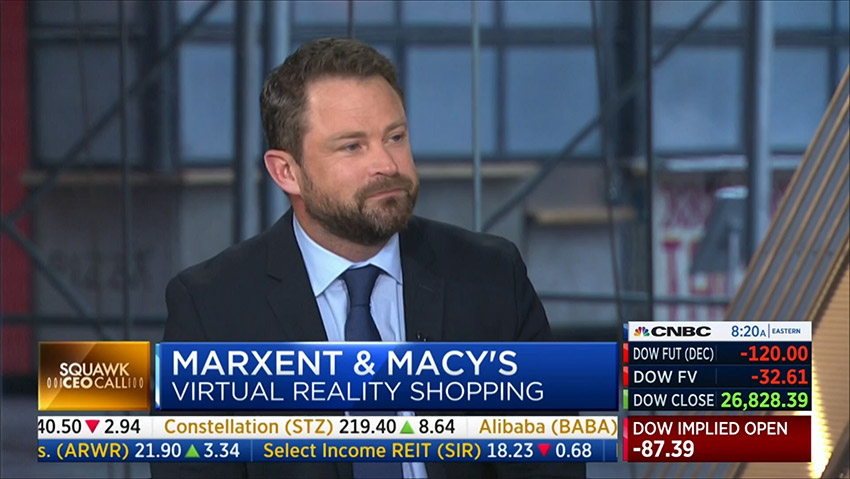- 3D Cloud’s CEO and Co-Founder, Beck Besecker, appeared on CNBC Squawk Box to talk about Virtual Reality’s impact on retail and 3D Cloudt’s Virtual Reality roll out with Macy’s
- VR for retail is redefining retail real estate. With VR, retailers can fit an entire 30k sf – 1M sf showroom (or even more) and assortment into 5k sf of space – or even less.
- Macy’s likes VR for furniture because it combines the human touch with technology for a great retail experience. It has also proven to deliver a 60 percent increase in basket size vs. non-VR sales and has reduced returns to 2 percent. The technology also provides them with space flexibility to experiment with other new retail and merchandising concepts.
- Macy’s has rolled VR out to 69 stores across the US.
Today, 3D Cloud’s CEO and Co-Founder Beck Besecker was featured on CNBC Squawk Box to talk about Virtual Reality shopping, the future of 3D in retail, how VR is redefining retail real estate and why Macy’s is leading the way in deploying emerging technologies at scale.
“Macy’s has truly led the retail industry in innovating with emerging technologies. They are leading the first nationwide rollout of VR to retail, 69 stores in major markets across the country are up and running. Macy’s has rolled 3D Cloud’s Virtual Reality and patent-pending 3D Room Planner with Photo to Floorplan™ out to 69 stores in the US and that’s just the beginning, Macy’s CEO Jeff Gennette said previously. Macy’s likes the technology because it offers increased conversion to sale, a 60 percent increase in basket size and reduces returns to less than 2 percent. The company also likes VR because it allows them to offer a full range of furniture in a dramatically smaller space — in fact about less than half the space.
“Furniture is this high margin high touch business for Macy’s, and we want it in as many stores as possible. If we choose to, we could put VR furniture in every Macy’s building,” Gennette said.
This new space flexibility allows companies like Macy’s to think about space productivity and introduce experimental retail concepts – such as pop-ups, smaller urban showrooms and eventually VR only kiosks. The technology gives them the ability to provide the most personalized furniture shopping experience with the maximum amount of SKUs in retail space that is the fraction of the size of current furniture showrooms. In the current environment, furniture showrooms can range in size from 10k sf to 1.3 million sf. With VR, it’s possible to put the same assortment, the same merchandising capabilities into a 5k sf footprint.
“While you were sleeping, VR grew up. It drives sales. It makes the endless aisle a reality for brick and mortar, with the personalized experience that customers expect. And it’s changing the retail footprint. This is happening right now,” Besecker said.
Macy’s Virtual Reality by the numbers:
- 69 stores
- Increased conversion to sale
- 60 percent increase in basket size vs. non-VR sales
- Return rates less than 2 percent
- Can fit an entire furniture showroom into 5k sf.
- Makes it possible to put furniture into every Macy’s store











